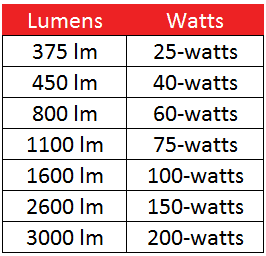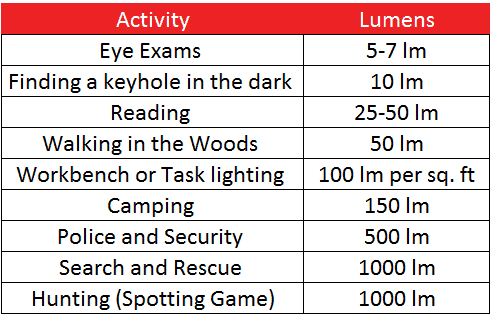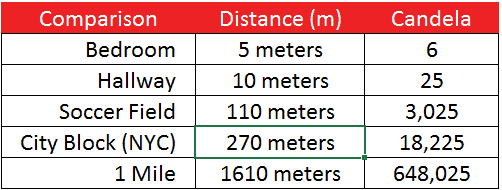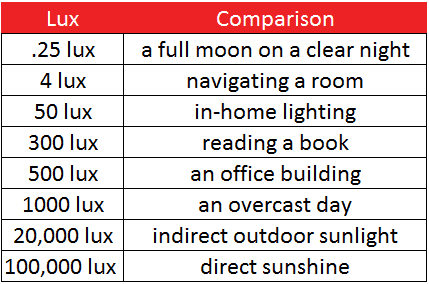Disclaimer: This article includes affiliate links. If you choose to purchase any of the products we have discussed in this article, we may receive a small, and much appreciated commission.
Lumens, Lux, and Candela are often misunderstood and used interchangeably while having distinctly different meanings. Understanding the difference can be very helpful when making lighting decisions.
What’s the difference between Lumens, Lux, and Candela?
To put it simply
Lumens is a measurement of how much light is emitted from a light source in all directions.
Lux measures the amount of light that falls on a surface.
Candela is light’s intensity as visible to the human eye in a specific direction.
The history of Candela goes back 150 years. The term candlepower – now mostly obsolete – was coined in 1869 according to Merriam-webster, and refers to a unit of luminous intensity. Between 1869 and 1948, a unit of candlepower was measured from a candle that was made from pure spermaceti (wax from sperm whales), weighed one-sixth of one pound, and burned at 120 grains per hour.
In 1948, the definition was changed to reference platinum and radiometry instead of whale wax and grains, and the term candlepower was replaced with Candela.
Use of the English word Lumen as a measure of light began in the late 1800s – more than 20 years after the coinage of the word candlepower. It was an adaptation of the Latin word lumen, which translates to English as light. Another adaptation of a Latin word, lux emerged in English around the same time. Like lumen, the Latin word lux also means light.
Let’s break each of these down to better understand them.
Lumens
What are Lumens? Lumens (lm), by definition, is a marketing term that is often misused to indicate flashlight quality. Wait…did I type that out loud?
What Does Lumens Measure?
Lumens is a measure of the total output from a light source in all directions. One Lumen is equal to one Candela of light at a distance of one meter from the light source, and we’ll see how that is measured further down.. If you want to focus on the overall brightness of a light, your material concern is Lumens. Lumens have replaced watts as the most advertised feature of today’s light bulbs.
It is important to reiterate one point. Lumens is the measure of the total light output from a light source in all directions.

Why Watts Don’t Matter Anymore
Lumens is a measurement of light output while Watts is a measurement of power or energy consumption over time. Clearly Watts and Lumens really don’t measure the same thing.
Converting Watts to Lumens
There is no easy conversion between Watts and Lumens without taking into account the light source. Let’s look at the equation for Watts:
Watts = Amps x Volts
We learned before that Lumens is a measurement of total light output, but there is no mention of light in the equation above. More info on Watts can be found in this video.
So what is the deal with watts advertised on household light bulbs? When incandescent bulbs were the mainstay of lighting across the land, the same or similar materials were used in their manufacture.
When the light bulb materials are consistent, the variable in brightness becomes the amount of power behind the bulb. More Watts meant a brighter bulb and more light output in a way that the average person could understand.
Different light sources such as incandescent, halogen, fluorescent, LED and others produce light at different energy efficiencies. Measuring brightness by Lumens takes the bulb type out of the equation and focuses only on the brightness of the bulb or emitter.
To illustrate the difference in bulb types, each of these bulbs emit roughly 1600 Lumens:

You can see the variability between Watts and Lumens based on different light source types. Notice that the Light-emitting Diode (LED) bulb emits 1,600 lumens using only 22 watts. LED bulbs are the most energy-efficient of those shown above using less than ¼ of the energy of an incandescent bulb.
Power consumption (Watts) is always an important factor in lighting. Yet, it is clear that Watts is no longer the indicator of light brightness that is used to be. Therefore watts is no longer as relevant in making a buying decision with today’s LED lights.
How to Measure Lumens
Since Lumens is a measure of total light output in all directions, then all of that light must be captured for an accurate measurement. This is best done using a device called an Integrating Sphere.
An Integrating Sphere is an enclosed spherical device with a reflective interior surface. A light source is inserted into a small port and sealed to prevent ‘light leakage’ and a light sensor inserted into another port.
Placing a baffle between the light source and meter prevents light intensity from affecting the result. The interior of the sphere is white or gold and very reflective without being shiny.
The reflective surface reflects and diffuses all of the output from the light source for accurate measurement by the light meter.
Newport.com has more information on Integrating Spheres here.
Guess what? That snazzy 2000 Lumen flashlight that you bought at the department store or on eBay may not produce the Lumens that it says on the box. Shocking, I know. How do they justify it?
It turns out (as explained by jwspeaker.com) that there are two kinds of Lumens – Raw Lumens and Effective Lumens
Raw Lumens – The theoretical output of an LED light. In practice, the LED emitter that a manufacturer uses in their device comes with a Lumen rating from the factory, given ideal conditions The device manufacturer then multiplies that LED emitter’s Lumen rating by the number of LED emitters in the device, coming up with a very nice sounding Lumens number that they can put on the box in large, impressive numbers.
Effective Lumens – The actual measured Lumens that a light produces. This considers factors such as Thermal, Optical, and Assembly loss. A variety of components from the electrical circuits affecting the voltage to the lens itself can affect the amount of light put out by an emitter. Effective Lumens are measured using the Integrated Sphere we discussed before.
Here is what measuring light output looks like in a lab.
OK, so obtaining and using an Integrated Sphere is a bit much to go through to verify that your $20 flashlight can really put out 2000 Lumens, and you’re right. Plus Integrating Spheres are several thousand dollars by themselves!
Several flashlight reviewers online have more down-to-earth methods of measuring Lumens. There are some good DIY device designs such as using a curved PVC pipe or a white box like a cooler with holes that can provide similar results.
Here’s a build video of Matt Smith’s DIY testing device.
It’s not perfect but it gets the job done and is good enough for YouTube.
How Many Lumens is a 60 Watt Bulb?
A 60-watt bulb is roughly 800 Lumens.
OK, we just covered why Watts no longer matter as an indicator of brightness. But many of us were raised in a house full of 40-watt or 60-watt bulbs and are used to watts as a measurement. If Lumens is now the best way to measure brightness, how do the two compare?
Here is a comparison chart of standard household incandescent bulbs and their estimated Lumens output (voltlighting.com).

How Many Lumens Do I Need?
But how much is enough for your needs? Believe it or not, you do not always want the brightest flashlight. Here is a rough idea of the levels of Lumens you should be looking for depending on your use:

Some of these values are pretty low. Personally, I enjoy a very low or even no light when walking in the woods.
Some of the brightest flashlights you can find on the market produce more than 10,000 lumens. Manufacturers are currently working toward raising this number to ever greater heights. To do this, Manufacturers adjust Lumens by adjusting electrical input, hardware components, circuitry design, and emitter or bulb efficiency.
Candela
Candela is light’s intensity as visible to the human eye in a specific direction. Candela is a direct indicator of Throw, or the effective distance of a directional light such as a flashlight.
What does Candela measure?
Candela – formerly known as candlepower – is a measure of light intensity in a specific direction. More specifically, one Candela is the measurement of light from one candle at a distance of one meter in a specific direction.
If the emission of light is blocked in one direction, the measurement remains one candela in the unblocked direction(s). However, if light is reflected instead of blocked, more light is cast to the same direction, making it more intense and raising the Candela.
Candela is a measurement of light intensity, so would increase accordingly as light is focused in a tighter, more directional beam.
That’s the simple way of looking at Candela. Here is the more technical definition, redefined by the 26th General Conference on Weights and Measures (CGPM) and taking effect in May 2019:
The Candela […] is defined by taking the fixed numerical value of the luminous efficacy of monochromatic radiation of frequency 540 × 1012 Hz, Kcd, to be 683 when expressed in the unit lm W–1, which is equal to cd sr W–1, or cd sr kg–1 m–2 s3, where the kilogram, meter and second are defined in terms of h, c, and ΔνCs.
How to Measure Candela
Candela can be directly measured but the values on your flashlight box are likely calculated from other factors. Candela is a product of Lumens and the angle of the beam reflector, referred to as the Beam Angle.
Here’s where we get to some higher math with Pi’s, Cosines, Steradians, and other math concepts I left behind in High School a long time ago.
But don’t let me dissuade you. If you are interested in the math behind the madness, I refer you to a deep dive into the topic provided by ledwatcher.com.
There is a way to measure your own Candela by shining the brightest part of your light (called the ‘hot spot’ onto a light or lux meter at a known distance away. Take your lux reading and distance, and input it into the online Candela calculator at rapidtables.com for a result.
YouTuber AdvancedKnifeBro has an entertaining YouTube video illustrating the process. I bookmarked the video below at the Candela measurement.
How to Increase Candela
Increasing Candela means increasing the light intensity in one direction using a reflector. A reflector is a surface that shapes and focuses most or all of the light coming from a light source.
Candela is mainly used for directional lights, such as flashlights. It’s not really a factor in your standard household light bulb or other lights designed to illuminate an area.
All flashlights have some type of reflector in a variety of shapes, sizes, and materials. Large, parabolic reflectors with smooth mirrored surfaces give the highest amount of Candela. These reflectors focus the light into a tight, directional beam.
Smaller reflectors with rough surfaces (otherwise known as Orange Peel or OP for short) scatter light in a wider area. This reduces the intensity in a specific direction and lowers Candela.
Since the reflector shapes the light it is the largest factor in Candela. The other way of increasing the Candela is the light source itself. In the case of an LED flashlight, that means the LED emitter.
A larger or more powerful LED emitter puts out more Lumens. And more Lumens through the same reflector means more light being shaped in the direction of measurement. More light means more Candela.
There are also factors of voltages, control boards and assembly factors to consider, but those are deep rabbit holes to travel down. I think for discussion we can agree in general that bigger is better, right?
Candela Distance Chart
Distance, or Throw, is calculated directly from Candela. Here is a chart of some examples and respective Candela distance:

Calculating Throw from Candela is fairly easy:
Throw (in meters) = Sq. Root of Candela x 2
Given this formula, a flashlight with 1 Million Candela will have a throw of roughly 2000 Meters. That’s almost 1 ¼ miles for the Americans.
Lux – What Does it Measure?
Lux is a measure of the amount of light that hits or passes through a surface or object. Expressed singularly in English (Lux – not luxes), one Lux equals one Lumen on a square meter of surface area. In other words, 1,000 lumens directed toward 1 square meter will illuminate that area with 1,000 lux.
1,000 lumens spread over 10 square yards illuminate the larger area with only 100 lux. Increasing the target’s size, distance, or angle decreases Lux.
In other words, less light falls on objects that are farther away or are more angled. Lux correspondingly decreases with distance due to the Inverse Square Law.
The Inverse Square Law tells us that the intensity of light falling on an object is inversely proportional to the distance to the object squared. In other words, if distance from a light source is doubled, the light dissipates (or ‘falls off’ as the photographers say) by four times. This is because the same light is now spread across four times the area.
OK, that’s a lot of words to digest. It is better illustrated by the handy butter gun!
How to Measure Lux
Lux is measured using a simple, hand held light meter. They are sometimes called Lux meters but the term is interchangeable. These can be found for a nominal cost from Amazon or other sources.
Simply place the light meter on an object to measure the light which is falling on it from a light source. The meter can provide a light measurement in Lux or in foot-candles.
Oh – there’s a new term: foot-candle. Lux and foot-candle measure the same thing just at different distances. If Lux measures the light falling on a surface one meter away from the source, foot-candle measures light one foot away from it.
Use the formula below to convert values between foot-candle and Lux:
1 foot-candle = 10.764 Lux
There’s that pesky math again. I’ll stick to Lux and keep it simple.
Lux Comparison Chart
Here some examples of Lux levels you may experience on a regular basis:

How do Lumens, Candela, and Lux relate to each other?
Now that you fully understand Lumens, Lux, and Candela, let’s see how these three measurements relate to each other.
Lumens are the measurement of the total amount of light coming from a light source.
The reflector’s shape and surface, along with Lumens, determines the Candela or Throw of the light.
The amount of light that falls on or through a target is the Lux, which is affected by distance and angle.
Now that you have a handle on how Lumens, Lux, and Candela relate, here are some other articles on our site to review:
